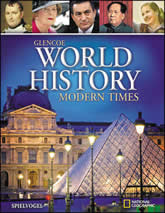Glencoe World History Modern Times © 2010Chapter 2:
Ancient Greece and RomeChapter OverviewsEarly Greek civilization consisted of many small, independent city-states. Trade led to Greek colonies, and Greek civilization gradually spread throughout the Mediterranean world. Rome began as a small village and became the seat of power of one of the greatest empires the world has known. Section 1 Ancient Greece
The Mycenaean civilization consisted of powerful monarchies that flourished between 1600 B.C. and 1100 B.C. on the Greek mainland. After the collapse of this civilization, Greece entered a period known as the Dark Age. Homer wrote his famous epic poems, the Iliad and the Odyssey. The polis, or independent city-state, became the focus of Greek life. In Sparta, a military state, an oligarchy decided what issues to place before adult male voters. In Athens, aristocratic rule dissolved into political strife between peasants and aristocrats. Leadership shifted between reform-minded aristocrats and tyrants, until land reform and an assembly served as the foundations of Athenian democracy. During the Age of Pericles, the Greek empire expanded. At home, a direct democracy flourished, in which all adult male citizens could vote. Distrust between Athens and Sparta led to the Great Peloponnesian War. After Athens was badly defeated, Sparta, Athens, and Thebes struggled to dominate Greek affairs. Classical Greek art—which sought to express reason, moderation, balance, and harmony—is reflected in temples and sculptures. Greek drama developed during this period. Classical Greek philosophers, such as Socrates, Plato, and Aristotle, devoted themselves to rational thought as a means of understanding the nature of the universe. In 359 B.C., Philip II came to the throne in Macedonia and defeated the Greeks. Philip's son Alexander, who became known as Alexander the Great, defeated the Persian Empire and expanded his empire as far east as modern Pakistan. Although Alexander's empire was short-lived, it was successful in spreading Greek culture in the region. Alexander's reign was known as the Hellenistic Era, and Greek colonies thrived in Southwest Asia, and important works of science, philosophy, art, and architecture were produced throughout the Hellenistic world. Section 2 Rome and the Rise of Christianity
Rome was strategically situated inland on hills along the Tiber River. In 509 B.C., the Romans overthrew the Etruscan kings based north of Rome and established a republic. Over several centuries, Rome brought most of Italy under its control. By 133 B.C., Rome was master of the Mediterranean region. Wealthy patrician landowners in the Roman Senate dominated the early republic. Plebeians voted and served in the army, but they could not marry patricians or be elected. Although all male Roman citizens were proclaimed equal under the law in 287 B.C., a few aristocrats dominated the Roman state by the second century B.C. The republic faced a period of civil war. Julius Caesar marched on Rome with his troops, and eventually he was declared dictator. Caesar's rule ended when he was assassinated. Octavian became Emperor Augustus, and the Roman Empire expanded its borders until, at its height, it had a population of more than 50 million. Trade and commerce thrived. The Romans imitated Greek culture in some respects, but they also developed their own realistic style of sculpture, introduced the use of concrete in construction, and displayed impressive feats of engineering in their roads, bridges, and aqueducts. One of Rome’s chief gifts to the world was its system of law and standards of justice. Christianity emerged at a time of widespread unrest in the Roman province of Judaea. Jesus preached a message of humility, charity, and love. Jewish followers saw him as the Savior. Opponents denounced him, however, and turned him over to the Roman authorities, who saw Jesus as a potential revolutionary. After Jesus' crucifixion, Paul took the message of Jesus to Jews and non-Jews. Romans viewed Christianity as a threat to the state, and Christians often faced persecution. In the fourth century, the emperor Constantine proclaimed official tolerance of Christianity, setting the stage for its adoption as the empire's official religion. Conflict and confusion followed the death of Marcus Aurelius, the last of the five good emperors. Invasions, civil wars, and plague brought the empire to the brink of economic collapse. Diocletian and Constantine restored at least temporary stability to the empire. Diocletian deemed the empire too large for one emperor and divided it into four units, each with its own ruler. The Greek city of Byzantium, renamed Constantinople, became the capital of the eastern part of the empire, while invading Germanic tribes put increasing pressure on the western part of the empire. Rome was sacked by two invading tribes, first the Visigoths, then the Vandals. The western emperor, Romulus Augustulus, was deposed by the Germanic head of the Roman army in 476, marking the fall of the Western Roman Empire.  | 
















